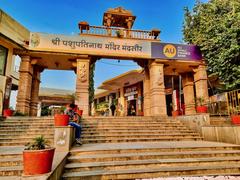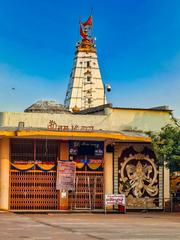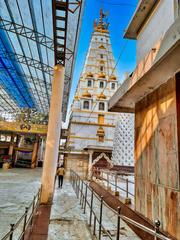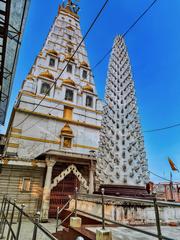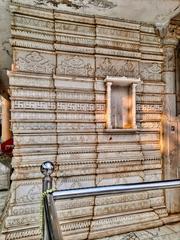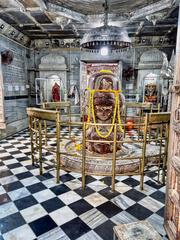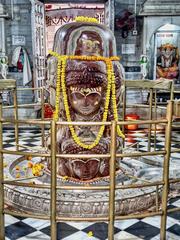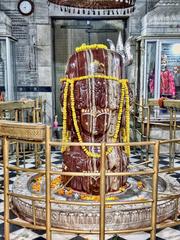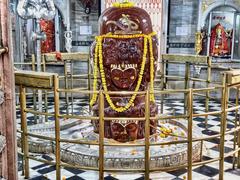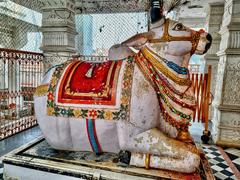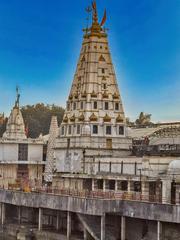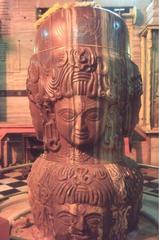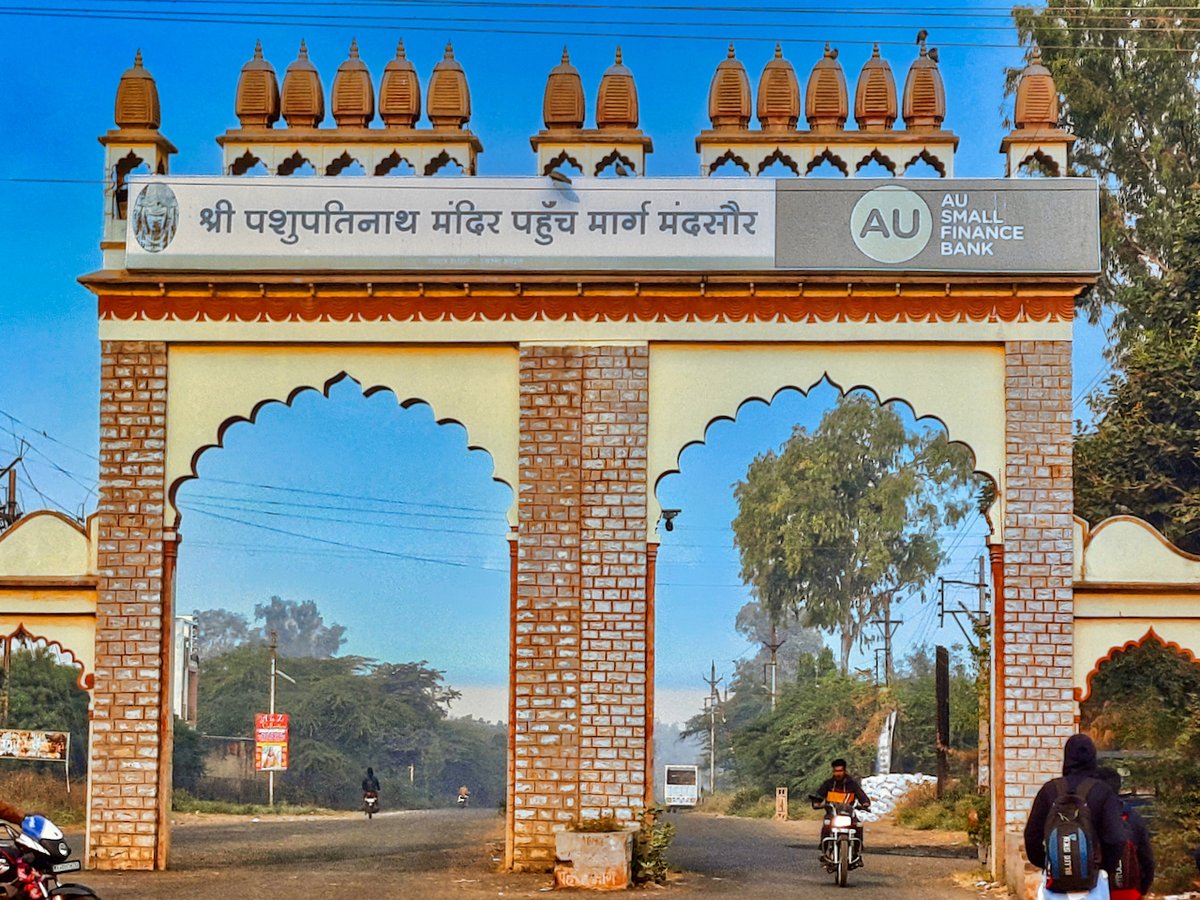
Pashupatinath Temple Mandsaur: Visiting Hours, Tickets, and Travel Guide
Date: 15/06/2025
Introduction
The Pashupatinath Temple in Mandsaur, Madhya Pradesh, is a remarkable blend of spiritual aura, historical depth, and architectural grandeur. Revered for its rare Ashtamukhi (eight-faced) Shiva Lingam—carved from a single monolithic stone—this ancient temple, dating from the 10th to 12th centuries CE, stands as a testament to the enduring legacy of Shaivism in central India. Its Nagara-style architecture, intricate carvings, and vibrant religious traditions make it a focal point for devotees, historians, and cultural travelers alike. Conveniently located and managed by the Archaeological Survey of India, the temple is accessible to all, including differently-abled visitors, and serves as a hub for major Hindu festivals, especially Maha Shivaratri. This comprehensive guide provides everything you need to plan your visit, including details on visiting hours, rituals, tickets, travel routes, accommodation, nearby attractions, and practical tips.
For official updates and detailed visitor information, refer to LightUpTemples: Mandsaur Sri Pashupatinath Temple, Mandsaur District Official Tourism, and Free Press Journal report on temple recognition.
Table of Contents
- Origins and Historical Evolution
- Architectural Distinctiveness
- Religious and Mythological Significance
- Festivals, Rituals, and Daily Worship
- Visitor Information: Hours, Tickets, Dress Code, and Accessibility
- Travel Options and Accommodation
- Nearby Attractions
- Practical Tips and Frequently Asked Questions (FAQs)
- Conclusion and Recommendations
- Sources
Origins and Historical Evolution
The Pashupatinath Temple’s origins are rooted in both Puranic references and regional legend. Estimated to be over a millennium old, the site is dedicated to Lord Shiva as Pashupatinath—“Lord of All Living Beings.” Historical records and archaeological studies date the temple’s construction between the 10th and 12th centuries CE, highlighting the flourishing of Shaivism in Malwa. The Archaeological Survey of India now oversees its preservation, ensuring that both its religious and historical significance are maintained for future generations (LightUpTemples).
Architectural Distinctiveness
The temple’s unique Ashtamukhi (eight-faced) Shiva Lingam is carved from a single block of stone, weighing approximately 4,600 kg and standing over 11 feet high. Each face depicts a different aspect of Shiva, symbolizing his omnipresence and multifaceted nature. The Nagara-style spire (shikhara), ornate gateways, sculpted panels, and subsidiary shrines add to the temple’s architectural splendor. The sanctum is accessible from four directions, and the western entrance aligns with the most expressive faces of the lingam. Delicate stone carvings on walls and pillars depict deities and mythological scenes, with a prominent statue of Nandi, Shiva’s sacred bull, facing the main shrine (mandsaur.nic.in).
Religious and Mythological Significance
According to legend and references in the Skanda Purana, the temple marks the spot where Lord Shiva appeared as Pashupatinath to bless his devotees. The eight-faced lingam is considered highly auspicious, attracting pilgrims seeking blessings, spiritual merit, and inner purification. The adjacent presence of Parvati, worshipped as Sri Pashupatinath Amman, deepens the temple’s spiritual significance for both Shaiva and Shakta followers (LightUpTemples).
Festivals, Rituals, and Daily Worship
Major Festivals
- Maha Shivaratri: The most significant festival, celebrated annually, attracts thousands of devotees for all-night vigils, special abhishekams, and vibrant cultural events. The temple is adorned with lamps and flowers, and special rituals are believed to bring spiritual merit (Myoksha).
- Shravan (Sawan Somvar): Mondays during the Shravan month (July–August) see heightened worship, fasting, and special poojas, with extended temple hours.
- Kartik Purnima: Celebrated on the full moon of Kartik (October–November) with ritual river baths and grand evening aartis.
Other Festivals
- Teej: Women pray for marital happiness, with festive processions and devotional music.
- Baisakh Purnima: Marks the Hindu New Year with community worship.
- Bala Chaturdashi: Observed with prayers for departed souls.
Daily Rituals
- Rudrabhishek: Daily bathing of the Shiva Lingam with sacred substances, accompanied by Vedic chanting.
- Aarti and Bhajan: Morning and evening aartis with devotional singing and drumbeats create a vibrant spiritual ambiance.
- Special Poojas: Devotees can sponsor rituals like Mahamrityunjaya Jaap or Laghu Rudra for blessings.
- Fasting: Common during major festivals and observed by many devotees.
Unique Practices
- River Rituals: Pilgrims often begin their temple visit with a purifying dip in the Shivna River.
- Circumambulation: Devotees walk around the Ashtamukhi Lingam, offering prayers to each face (Prabhat Khabar).
Visitor Information: Hours, Tickets, Dress Code, and Accessibility
Visiting Hours
- Open daily: 6:00 AM to 8:00 PM (hours may extend during major festivals).
Entry and Tickets
- General Entry: Free for all visitors.
- Special Poojas: Can be booked at the temple office for a nominal fee.
Dress Code and Conduct
- Attire: Modest clothing is required. Shoulders and knees must be covered; remove footwear before entering.
- Conduct: Respect temple rituals, priests, and fellow devotees. Silence is appreciated within the sanctum (Tourist Secrets).
Accessibility and Facilities
- Accessibility: Ramps and support for differently-abled visitors.
- Amenities: Drinking water, restrooms, shoe storage, and prasad distribution. Local vegetarian eateries are nearby.
- Photography: Permitted in most areas except within the sanctum. Always check for current rules.
Travel Options and Accommodation
By Air
- Nearest Airport: Devi Ahilya Bai Holkar Airport, Indore (approx. 250 km). Taxis and buses are available for onward travel (Madhya Pradesh Tourism).
By Rail
- Mandsaur Railway Station: Well-connected to major cities; about 3 km from the temple.
By Road
- Bus and Taxi: Good road connectivity to Indore, Ujjain, Kota, and Chittorgarh. Self-drive options and private taxis are also available.
Accommodation
- Gandhisagar Floating Festival Tent City: Luxury tents with river views and adventure activities (Gandhisagar Forest Retreat).
- Hinglaj Resort: Comfortable rooms managed by the state tourism department.
- Local Hotels and Guesthouses: Options near the city center and railway station. Advance booking is recommended during festivals.
Nearby Attractions
- Mandsaur Fort: Historic site with robust architecture (Madhya Pradesh Tourism).
- Dharmrajeshwar Temple: Ancient rock-cut temple complex.
- Malasari Island: Peaceful island accessible by boat.
- Teliya Lake: Ideal for sunrise and sunset.
- Bandi Ji ka Bagh: Jain temple with unique glass interiors.
- Sondani Archaeological Park: Notable for its early medieval sculptures and inscriptions.
Practical Tips and Frequently Asked Questions
Travel and Visit Tips
- Visit early morning or late evening for a peaceful experience.
- Dress appropriately; carry water and sun protection.
- Book poojas or guided tours in advance, especially during festivals.
- Use local transport like auto-rickshaws for easy commuting.
FAQs
Q: What are the temple’s visiting hours?
A: 6:00 AM to 8:00 PM daily; extended during festivals.
Q: Is there an entry fee?
A: No, entry is free. Special rituals have a nominal fee.
Q: Can non-Hindus enter?
A: Non-Hindus may not access the innermost sanctum but can observe from designated areas.
Q: Are guided tours available?
A: Yes, through local agencies or at the temple premises.
Q: Is the temple accessible to differently-abled visitors?
A: Yes, ramps and support are available in most areas.
Q: Is photography allowed?
A: Yes, except inside the sanctum; always check current restrictions.
Conclusion and Recommendations
The Pashupatinath Temple in Mandsaur is not just a place of worship, but a living heritage site that offers a unique blend of devotion, art, and culture. Free entry, extended visiting hours during festivals, and a welcoming environment make it accessible to all. The rich tradition of rituals and the rare Ashtamukhi Shiva Lingam provide an immersive experience for pilgrims and history enthusiasts alike. With its proximity to other historical sites and natural attractions, a visit to Mandsaur promises much more than just a spiritual journey. For the latest updates, festival schedules, and travel tips, use resources like the official tourism site, LightUpTemples, and the Audiala app for real-time information and guided experiences.
Sources
- Pashupatinath Temple Mandsaur: Visiting Hours, Tickets, History & Travel Guide, 2025, LightUpTemples
- Discover Pashupatinath Temple Mandsaur: Your Complete Visitor’s Guide, 2025, Mandsaur District Official Tourism
- Madhya Pradesh Pashupatinath Temple Gains Global Recognition in ITCX 2025, 2025, Free Press Journal
- Pashupatinath Temple Mandsaur: Festivals, Rituals, Visiting Hours, and Nearby Attractions, 2025, Myoksha and Prabhat Khabar, https://www.prabhatkhabar.com/life-and-style/travel/history-of-1500-years-old-ashtamukhi-pashupatinath-temple-in-mandsaur-mp
- Pashupatinath Temple Mandsaur Visiting Hours, Tickets, and Travel Guide, 2025, Madhya Pradesh Tourism and Gandhisagar Forest Retreat, https://gandhisagarforestretreat.com/best-accommodation-option-near-mandsaur-madhya-pradesh/

